Article: Giving Textiles a New Lease of Life by Eloise Rapp
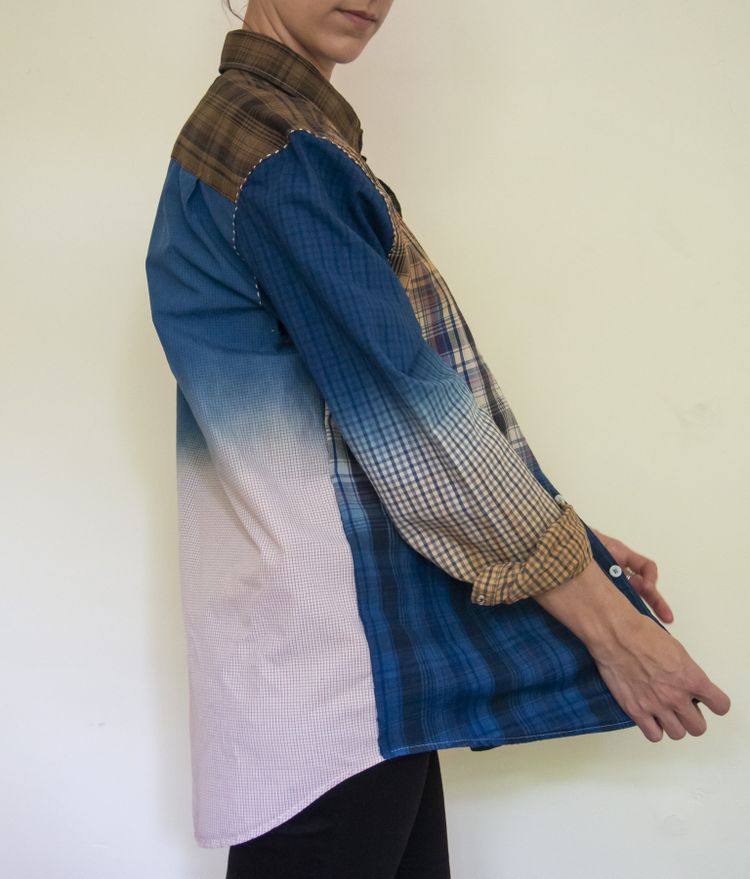
Eloise Rapp, Assemblage Shirt, 2021 Photo: Chris Gaul
Decommissioned cotton business shirts are disassembled, broken down into a series of rectangles and reconstructed in a patched arrangement that resembles the original checks and grids of the cloth. This new textile structure reexamines and recontextualises the original purpose of the shirting. One of the pieces I left undyed, and the other I dyed with naturally fermented indigo, a pigment that has long held a relationship with cotton workwear. My intention in presenting the same cloth in two colourways is to illustrate that one of the easiest steps towards reviving our old textiles is by simply changing their colour. I’m always looking for the least amount of intervention required to revalue and elevate an existing textile.
The title is both a nod to the universality of gingham, check & plaid and a critique on the urgent need to make use of what we have; to recognise our old textiles as robust materials we must actively care for, repair and re-value. Shirts are my ideal medium because they are in and of themselves a perfect wearable system — their silhouettes universal and non-gendered, with a versatile fibre structure that allows them to be endlessly remade. They are discarded in abundance and accessible by all.
What fascinates me about textiles are the systems they support, create, and have the potential to improve. Push Pull Textiles, my design studio, is just me. I am responsible for all design and production. However, whenever I embark on a new project, I know that I’m actually mobilising a network and community of people — farmers, primary producers, mills, dyeing suppliers, recycling hubs, charitable organisations, other small businesses and makers. I’m part of some kind of local economy, which, most importantly, is part of a local ecosystem — or several local ecosystems which exist in the Asia-Pacific region. Finding creative ways to support these networks whilst working within ecological boundaries is what led me to start Push Pull Textiles.
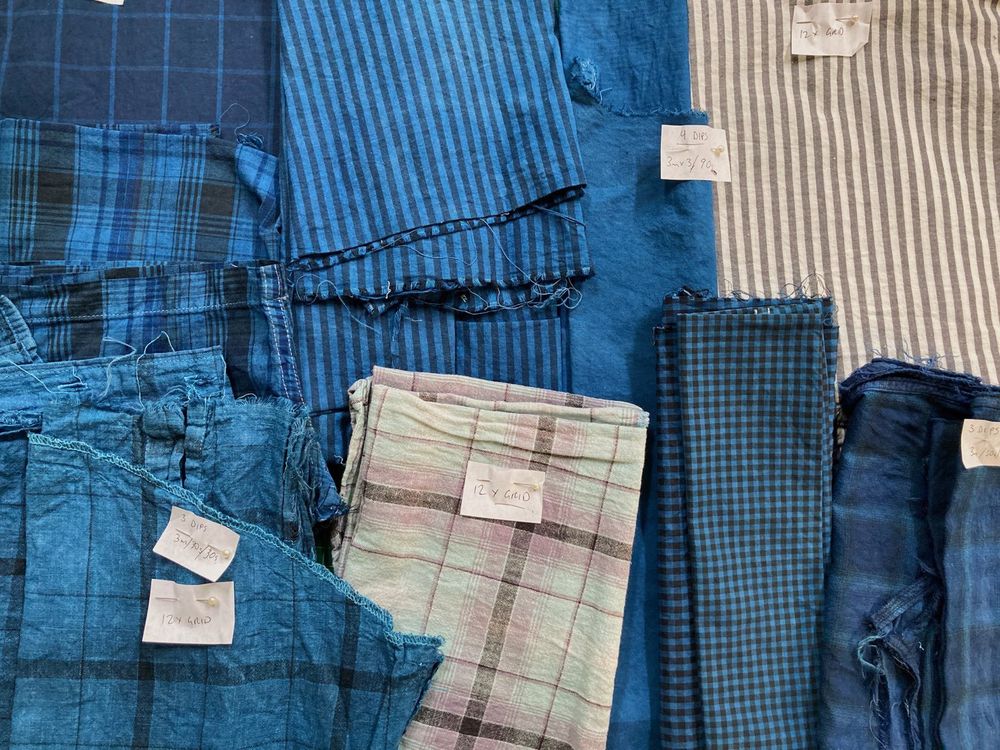
Image: material preparation, indigo-dyed and un-dyed shirting. Photo: Eloise Rapp Courtesy the Artist
I’ve been working with textiles in some form or another for over 15 years. When I left university and started my first job as a print designer for womenswear, I imagined, somewhat naively, that I would have the scope to fully express my values through commercial designing. It took me several years to understand that what I’d accepted as a normal way of working was deeply flawed. The reality is that, over the last hundred years at least, the fashion and textile industry has grown from its origin as a series of small, place-based and regenerative local economies into a global juggernaut of extractive and unethical practices. Those of us trying to hit the reset button in the face of such a force are often left feeling frustrated, guilty and discouraged. As we’re seeing, the power to define what sustainable textiles and fashion constitutes is dominated by retail giants and luxury conglomerates, whose savvy marketing techniques draw our attention away from the real problem, and allow them to keep manufacturing in perpetuity — business-as-usual. But as we all know by now, we are well beyond business-as-usual.
In the face of expansive ecological and social crises, designers are now faced with their own crisis of conscience: What is my intent? What is the purpose of this product? Who will it support, and who will it harm? Does this product even need to exist? Designers are people who generally want to solve problems through creative expression and engagement, which means we can often struggle to find practical ways of matching our beliefs with ‘sensible business decisions’. But we know there is a place for beautiful clothing and textiles that promote care for people and the planet. Clothes are not only essential items for humans, but one of our greatest forms of creative expression. So surely, as trained problem-solvers, we can find smarter ways to address the impact of their over-production.
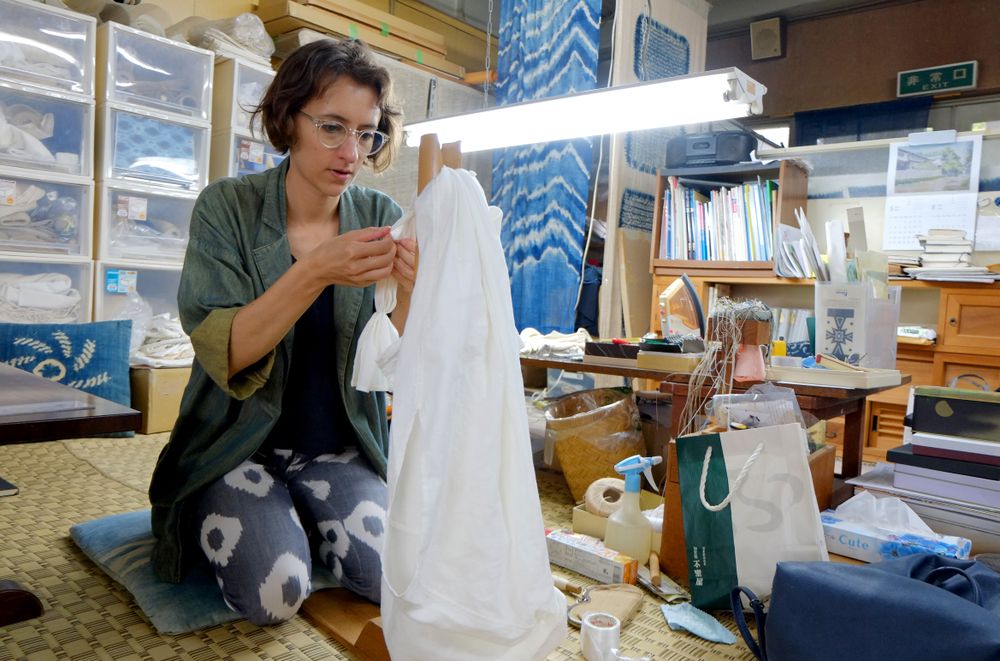
Shibori training in Kyoto, 2018 Photo: Yuko Sugie
I think this paradigm shift won’t come from tech, though it does of course play a role; nor will it come from the fantasy of green growth and the companies who tempt us with that alternate reality. It can only come from seeing ourselves as inseparable from the natural world. Everything we make must now, and urgently, promote and not deteriorate the health of soil, sea, sky and species.
The obvious outcome of this paradigm shift in regards to textiles is to make nothing new. This should always be the first decision. However, we also have a vast resource in front of us that we can tap into to slow down this runaway growth. And that is, of course, existing textile waste, languishing in warehouses, wardrobes and landfills everywhere.
When I say vast resource, I don’t mean something that is or should be available to us in perpetuity. These kinds of mistakes of resource allocation are what we’re currently paying for dearly. I prefer to think of textile waste as something we need to exhaust before we even consider the need for virgin materials. It’s like asking for seconds at the dinner table — don’t ask for more until you’ve finished what’s on your plate. And what is on our plate is a meal that will take us decades to finish. Waste is part of the damaging colonial legacy of wealthy countries, Australia definitely included. So when I refer to my practice as being responsible, part of this responsibility is, really, picking up my own garbage. And to me that means taking on the challenge of repurposing the junk — the textiles that, through the demands of economies of scale, have been allowed to diminish in quality and longevity through their production. I believe our textiles deserve better.
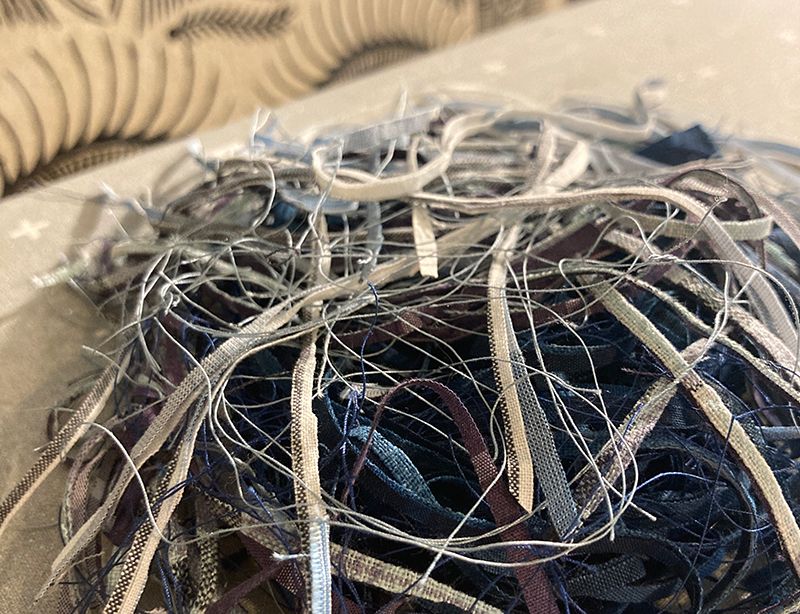
Image: Offcuts from the making of Gingham All You've Got Courtesy Eloise Rapp
I describe the way I work with textiles as a restorative — a restorative model of making. This means I look for ways to re-value these existing materials that have been discarded, damaged or are otherwise no longer fit for use. I do this generally by looking to the past, and applying the wisdom of pre-industrial, pre-capitalist methods and philosophies to contemporary challenges in design and manufacturing. This means limiting my modes of production to only low-impact methods of plant dyeing, loom weaving and experimental sewn construction of natural fibres. As an individual maker, of course, it’s a small impact. But my goal isn’t a personal set of statistics. It’s really to normalise this model of making within the wider manufacturing industry. To reconsider the need to extract non-renewable resources and instead, impart existing materials with meaning and longevity. In essence, my practice is about materials gaining, rather than losing, value.
Research and experimentation are crucial to my work because I’m always trying to find new ways of understanding materials, our relationship to them and their role in our everyday lives. I believe textiles should be immediately relatable and familiar to us. The more we understand about our textiles, the more likely we are to want to preserve them, and to ascribe a greater sense of value to them. When I embark on a new textile project, it’s important that I hold myself accountable to my own set of questions, like: What is the minimum amount of change that has to take place in order to re-value this material? How do I work with its existing qualities instead of in opposition to them? What potential impacts could arise from how I re-work this cloth? Being completely honest and open about both my successes and my shortcomings allows me to more effectively enact change. I believe that textile makers, however small-scale, can set a standard for responsibility and demonstrate the path to achieving it.
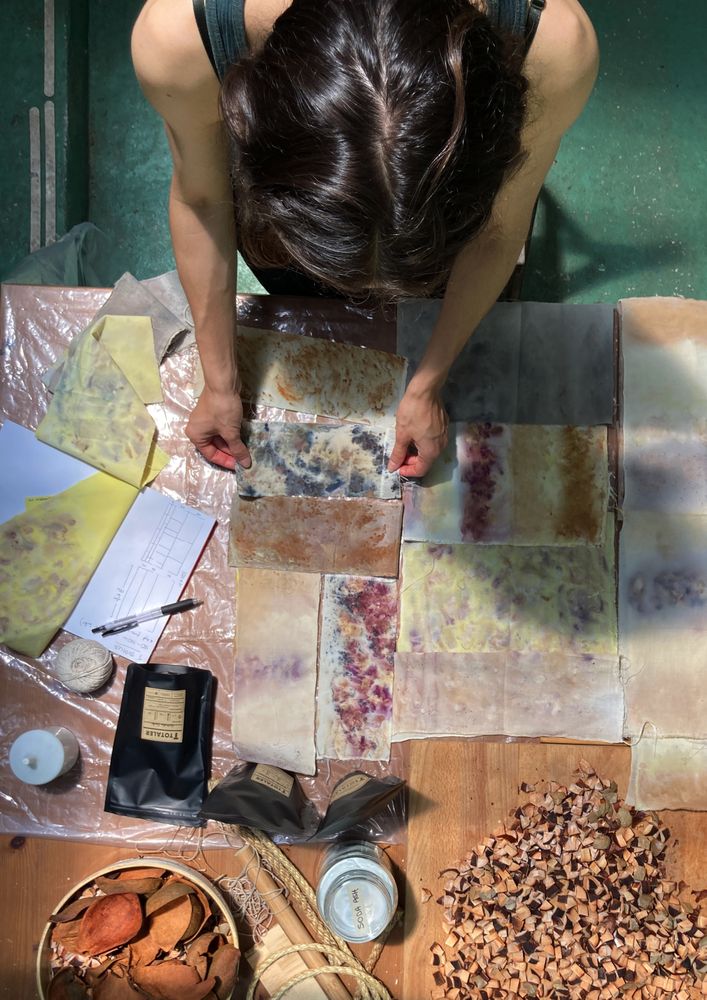
Eloise Rapp, natural dyeing application Photo: Courtesy of the Artist
The few years I spent studying textiles in Japan and Taiwan really helped in my understanding of the value of materials. I learnt about the innovation present in heritage modes of production, and how this is determined by local ecology. I formed relationships with practitioners, researchers and enthusiasts who are passionate about preserving material cultures. We discussed the cultural significance of certain crafts, how long it takes to attain proficiency and, often, their fears of them becoming twilight industries. I observed the ecosystems these micro-industries operate within and the communities that reverberate off them. In fact, the most lasting impression I have of these crafts is not of aesthetics or desirability — it’s of the interconnected systems they nurture.
I believe the place for time-honoured methods is here and now. People were hand dyeing, hand weaving and hand sewing for thousands of years before we mechanised and corporatised the means of production. And where I see these methods having the most impact on our current unsustainable models is in their ability to impose limits to production. These crafts are, by their very nature, ecologically limited. They rely almost entirely on human labour, with minimum mechanised intervention. They can’t be scaled excessively because they are tethered to regenerative natural cycles of raw material cultivation. They also have spiritual and familial significance — something we have all but lost in colonial-capitalist culture. Where handcraft economies are established, they directly support communities and the commons. And they have survived all these years because of the rich value they imbue in our clothing, furniture and objects of daily life. For me, this is what defines responsible making.
Something else I believe in is that limiting ourselves to working with existing materials offers endless possibilities. Consider the fact that in clothing design, we’ve always worked to a significant limitation: a head, two arms and two legs, plus all manner of anatomical variation that makes us human. Think of how much we’ve been able to create, and are yet-to-create, within this physical limitation. So when we consider working with the textiles and the textile waste we already have — does this not offer us endless freedom to create and innovate?
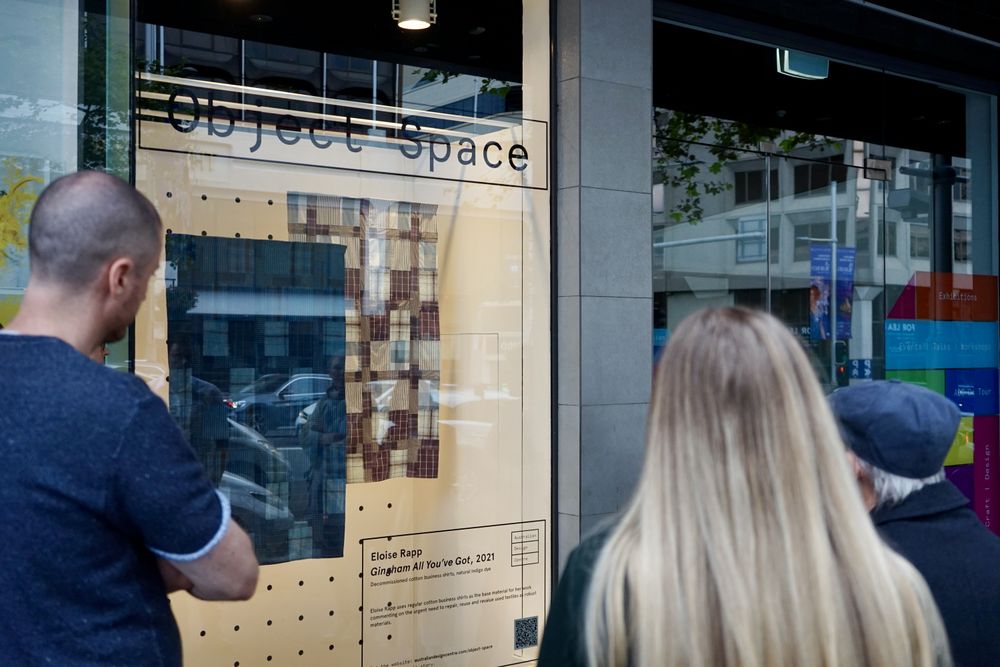
Eloise Rapp, Gingham All You've Got, Object Space, Artist Talk, Australian Design Centre, 2021 Courtesy of Australian Design Centre
While, like I said, there is a place for technological innovation, I truly believe that we’ll have more success turning the ship around if we invest more into innovation at the product design stage — designing out waste; use of mono-materials and natural fibres; employing design that adapts to the full range of bodies and dissolves the notion of gendered fashion. That is when we will truly be free to fully explore new ways forward in fashion and textile production. When we stop designing for people as consumers invested in a cycle of endless growth, and instead start designing for humans invested in a living, restorative, and reciprocal ecosphere.
Because of this, I see the textiles I create not so much as finished design objects, but as a blueprints for how textiles can be effectively remade and revalued. They’re really only the starting point in the immeasurable applications something like an old cotton shirt can provide. I don’t like to close the door on my textile projects. This was always a problem for me when I worked in commercial fashion studios, where products must have a definite full stop, lest they slow down the insane speed of delivery required to keep that market afloat. So I don’t consider, nor do I want what I make to ever seem finished. I like the concept of these pieces being just one iteration of an idea that can carry on after I’m done with it — that their lifespan can be non-linear, that any person, animal or natural process can intervene and decide what their next form will be.
Now is the time to be bold and brave with our designing. To rethink structure, silhouette, gendered and able-bodied fashion. To rethink the meaning of luxury and to throw classism in the bin. To confront the legacies of colonialism that have come to define how we manufacture textiles, and to repair these human relationships. Some refer to this approach as democratising design, but I simply see it as design succeeding in what it’s supposed to do.
This article was first delivered by Eloise Rapp as a talk on 17 April 2021 about the Object Space exhibition, Gingham All You’ve Got.
